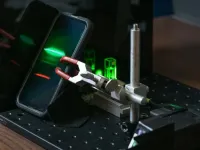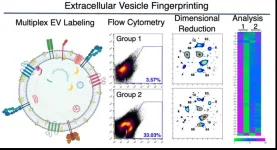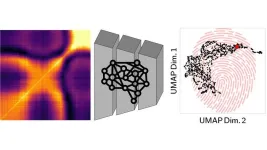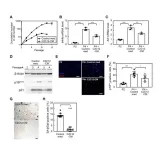(Press-News.org) Researchers at the University of Arizona Health Sciences identified a new way to make opioids safer, increasing the pain-relieving properties of opioids while decreasing unwanted side effects through the spinal inhibition of a Heat shock protein 90 isoform.
Opioids are the gold standard of chronic pain treatment, but they come with a host of negative side effects including constipation, addiction potential and respiratory depression that can lead to death. This study, published in Scientific Reports, offers a potential new way to treat acute and chronic pain by reducing the amount of opioid needed for pain relief while also lowering its addiction potential.
“We have been investigating the role of Heat shock protein 90 in regulating opioid signaling in the spinal cord for some time,” said John Streicher, PhD, member of the Comprehensive Center for Pain & Addiction at UArizona Health Sciences and a professor in the College of Medicine – Tucson’s Department of Pharmacology. “This study provides proof of principle that Hsp90 isoform inhibitors are effective at improving opioid pain relief and reducing side effects. This is the critical link that makes our work translationally relevant, giving us a clear path forward to develop a new drug that could benefit millions of people who live with chronic pain.”
Heat shock protein 90 is a chaperone protein that helps other proteins function, including those that promote tumor growth. It has been studied primarily in the context of cancer. Streicher is leading in a long-term effort to investigate its role in opioid receptor activation and pain relief.
Streicher’s prior research showed that Heat shock protein 90 acted upon opioid receptors in the brain differently than in the spinal cord. Inhibiting Hsp90 in the brain blocked the analgesic properties of morphine, meaning the opioid lost its ability to reduce the sensation of pain. But inhibiting Hsp90 in the spinal cord amplified the pain-relieving effects of morphine.
Building on that research, the team tested nonselective Hsp90 inhibitors in mouse models and saw a twofold-to-fourfold increase in the potency of pain relief provided by morphine. At the same time, tolerance was reduced and established tolerance was reversed. Tolerance is a condition where the body gets used to a medication so that more medication or a different medication is needed to achieve the same response.
Early cancer-focused studies, however, found that nonselective Hsp90 inhibitors can cause serious side effects, including macular degeneration. Streicher’s solution was to target individual isoforms of Hsp90, of which there are four.
“Isoforms are different versions of the same thing, like trim packages on a car,” Streicher said. “They are all slightly different and have similar roles, but not identical roles. So these four Hsp90 isoforms are four proteins that we can target individually.”
By using selective inhibitors to target each isoform, they were able to identify and isolate the isoforms that are active in the spinal cord from Hsp90-alpha, the one that is active in the brain. Recent reports have linked Hsp90-alpha with the serious side effect of retinal degeneration.
“We took isoform-selected inhibitors that we got from our collaborator, Brian Blagg, PhD, at the University of Notre Dame, and gave them to mice systemically via IV injection,” Streicher said. “We found that you can give these isoform-selective inhibitors by a translatable route and get the benefits. Pain relief goes up and side effects go down, and presumably we’re going to avoid some of those nasty side effects of the nonselective Hsp90 inhibitors.”
The findings suggest that selective Hsp90 inhibitors could be used as part of a dose-reduction plan in conjunction with opioid therapy prescribed by a physician for chronic pain. The goal is for doctors to be able to prescribe lower amounts of opioids that provide patients with the same pain-relieving benefits and fewer negative side effects.
“What I’m envisioning is you’d be given a pill that is a combination therapy of an opioid with one of these isoform inhibitors,” Streicher said. “The addition of that Hsp90 inhibitor would make the opioid better – it would increase the effectiveness of the pain relief and decrease the side effects.”
Streicher and his team are working to optimize the selective Hsp90 inhibitors to produce a stable drug that can be taken orally.
“Dr. Streicher’s research is an excellent example of the innovative, translational science that is needed to transform health care for pain and addiction,” said Todd Vanderah, PhD, director of the Comprehensive Center for Pain & Addiction, Regents Professor and head of the Department of Pharmacology. “This study is an important step toward developing a novel evidence-based therapy that will provide better treatment options with fewer disruptive side effects, empowering people with chronic pain to thrive.”
The research team included four co-first authors: David Duron, PhD, JD, former doctoral candidate in the Streicher Lab; Parthasaradhireddy Tanguturi, PhD, researcher/scientist in the Department of Pharmacology; former doctoral candidate Christopher Campbell, PhD; and Kerry Chou, former undergraduate student at the UArizona College of Nursing. Other co-authors included Paul Bejarano, and former doctoral candidates Katherin Gabriel, PhD, and Jessica Bowden, DVM, PhD, all of the Department of Pharmacology; Sanket Mishra, PhD, Christopher Brackett, PhD, and Brian Blagg, PhD, of the Department of Chemistry and Biochemistry at the University of Notre Dame’s College of Science; and Deborah Barlow and Karen Houseknecht, PhD, of the Department of Biomedical Sciences at the University of New England’s College of Osteopathic Medicine.
END
Research shows protein isoform inhibitors may hold the key to making opioids safer
A new University of Arizona Health Sciences-led study identified a viable path to developing a novel therapy that would make opioids more effective and safer as a treatment for chronic pain
2024-07-16
ELSE PRESS RELEASES FROM THIS DATE:
Pocket-sized invention revolutionizes ability to detect harmful materials
2024-07-16
Imagine knowing what berry or mushroom is safe to eat during a hike or swiftly detecting pathogens in a hospital setting that would traditionally require days to identify.
Identification and detection of drugs, chemicals and biological molecules invisible to the human eye can be made possible through the combined technology of a cellphone camera and a Raman spectrometer — a powerful laser chemical analysis method.
Dr. Peter Rentzepis, a professor in the Department of Electrical and Computer Engineering at Texas A&M ...
A new addition to the CRISPR toolbox: Teaching the gene scissors to detect RNA
2024-07-16
Bacteria have developed special defense mechanisms to protect themselves against viruses, which by no means infect only humans. As part of these so-called CRISPR-Cas systems, a CRISPR ribonucleic acid (crRNA), which serves as a “guide RNA,” recognizes regions of a foreign genome, such as viral DNA. The CRISPR-associated (Cas) nuclease, directed by a crRNA, then renders it harmless by cutting it like a pair of scissors. Humans have exploited this strategy: “CRISPR, often referred to as ‘gene scissors’, is the basis of many molecular technologies,” says ...
Vanderbilt scientists develop new tool that could lead to noninvasive “liquid biopsies”
2024-07-16
Biopsies are clinical tools commonly used to diagnose a variety of diseases or to monitor tissue for abnormal growth or even rejection of a transplant. During biopsies, tissue samples are removed from the body so they can be examined more closely, but depending on the type of tissue that’s needed, the procedure can be rather invasive.
Researchers from the School of Medicine Basic Sciences recently developed an analytical tool that could lead to the use of “liquid biopsies” as a substitute ...
Many breast cancer survivors do not receive genetic testing, despite being eligible
2024-07-16
ANN ARBOR, Michigan — As cancer treatment and survivorship care relies more on understanding the genetic make-up of an individual’s tumor, a new study from the University of Michigan Health Rogel Cancer Center finds that many breast cancer survivors who meet criteria for genetic counseling and testing are not receiving it.
The good news: Among those who do get testing, nearly two-thirds who have a genetic variant are reaching out to family members to talk about their results.
“Our findings support a rapidly growing movement to simplify clinical guidelines to ...
Scientists find that small regions of the brain can take micro-naps while the rest of the brain is awake and vice versa
2024-07-16
Sleep and wake: they’re totally distinct states of being that define the boundaries of our daily lives. For years, scientists have measured the difference between these instinctual brain processes by observing brain waves, with sleep characteristically defined by slow, long-lasting waves measured in tenths of seconds that travel across the whole organ.
For the first time, scientists have found that sleep can be detected by patterns of neuronal activity just milliseconds long, 1000 times shorter than a second, revealing a new way to study and understand the basic brain ...
Scientists develop new artificial intelligence method to create material ‘fingerprints’
2024-07-16
Study shows how materials change as they are stressed and relaxed.
Like people, materials evolve over time. They also behave differently when they are stressed and relaxed. Scientists looking to measure the dynamics of how materials change have developed a new technique that leverages X-ray photon correlation spectroscopy (XPCS), artificial intelligence (AI) and machine learning.
This technique creates “fingerprints” of different materials that can be read and analyzed by ...
Sun-like stars found orbiting hidden companions
2024-07-16
Most stars in our universe come in pairs. While our own Sun is a loner, many stars like our Sun orbit similar stars, while a host of other exotic pairings between stars and cosmic orbs pepper the universe. Black holes, for example, are often found orbiting each other. One pairing that has proved to be quite rare is that between a Sun-like star and a type of dead star called a neutron star.
Now, astronomers led by Caltech's Kareem El-Badry have uncovered what appear to be 21 neutron stars in orbit around stars like our Sun. Neutron stars are dense burned-out ...
Roles of PEDF in exercise-induced suppression of senescence and its impact on lung pathology in mice
2024-07-16
“[...] the present results strongly suggest the potential of PEDF as a myokine linking exercise training to the suppression of senescence.”
BUFFALO, NY- July 16, 2024 – A new research paper was published on the cover of Aging (listed by MEDLINE/PubMed as "Aging (Albany NY)" and "Aging-US" by Web of Science) Volume 16, Issue 13, entitled, “Roles of pigment epithelium-derived factor in exercise-induced suppression of senescence and its impact on lung pathology in mice.”
Senescent cells contribute ...
HER2-low and HER2-zero in breast cancer between prognosis, prediction and entity
2024-07-16
“[...] we found an independent positive prognostic effect of HER2-low compared to HER2-zero in early breast cancer.”
BUFFALO, NY- July 16, 2024 – A new editorial paper was published in Oncotarget's Volume 15 on June 20, 2024, entitled, “HER2-low and HER2-zero in breast cancer between prognosis, prediction and entity.”
In this new editorial, researchers Marcus Schmidt, Hans-Anton Lehr, and Katrin Almstedt from the University Medical Center of Johannes Gutenberg University discuss HER2 in breast cancer. HER2 is a well-established prognostic and predictive factor in breast ...
How to assess a general-purpose AI model’s reliability before it’s deployed
2024-07-16
CAMBRIDGE, MA — Foundation models are massive deep-learning models that have been pretrained on an enormous amount of general-purpose, unlabeled data. They can be applied to a variety of tasks, like generating images or answering customer questions.
But these models, which serve as the backbone for powerful artificial intelligence tools like ChatGPT and DALL-E, can offer up incorrect or misleading information. In a safety-critical situation, such as a pedestrian approaching a self-driving car, these mistakes could have serious consequences.
To help prevent such mistakes, researchers from MIT and the MIT-IBM Watson AI Lab developed a technique to estimate the reliability ...
LAST 30 PRESS RELEASES:
Ribosomal engineering creates “super-probiotic” bacteria
This self-powered eye tracker harnesses energy from blinking and is as comfortable as everyday glasses
Adverse prenatal exposures linked to higher rates of mental health issues, brain changes in adolescents
Restoring mitochondria shows promise for treating chronic nerve pain
Nature study identifies a molecular switch that controls transitions between single-celled and multicellular forms
USU chemists' CRISPR discovery could lead to single diagnostic test for COVID, flu, RSV
Early hominins from Morocco reveal an African lineage near the root of Homo sapiens
Small chimps, big risks: What chimps show us about our own behavior
We finally know how the most common types of planets are created
Thirty-year risk of cardiovascular disease among healthy women according to clinical thresholds of lipoprotein(a)
Yoga for opioid withdrawal and autonomic regulation
Gene therapy ‘switch’ may offer non-addictive pain relief
Study shows your genes determine how fast your DNA mutates with age
Common brain parasite can infect your immune cells. Here's why that's probably OK
International experts connect infections and aging through cellular senescence
An AI–DFT integrated framework accelerates materials discovery and design
Twist to reshape, shift to transform: Bilayer structure enables multifunctional imaging
CUNY Graduate Center and its academic partners awarded more than $1M by Google.org to advance statewide AI education through the Empire AI consortium
Mount Sinai Health system receives $8.5 million NIH grant renewal to advance research on long-term outcomes in children with congenital heart disease
Researchers develop treatment for advanced prostate cancer that could eliminate severe side effects
Keck Medicine of USC names Christian Pass chief financial officer
Inflatable fabric robotic arm picks apples
MD Anderson and SOPHiA GENETICS announce strategic collaboration to accelerate AI-driven precision oncology
Oil residues can travel over 5,000 miles on ocean debris, study finds
Korea University researchers discover that cholesterol-lowering drug can overcome chemotherapy resistance in triple-negative breast cancer
Ushikuvirus: A newly discovered giant virus may offer clues to the origin of life
Boosting the cell’s own cleanup
Movement matters: Light activity led to better survival in diabetes, heart, kidney disease
Method developed to identify best treatment combinations for glioblastoma based on unique cellular targets
Self-guided behavioral app helps children with epilepsy sleep earlier
[Press-News.org] Research shows protein isoform inhibitors may hold the key to making opioids saferA new University of Arizona Health Sciences-led study identified a viable path to developing a novel therapy that would make opioids more effective and safer as a treatment for chronic pain






